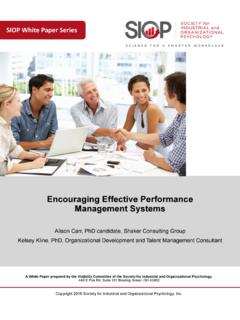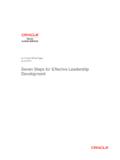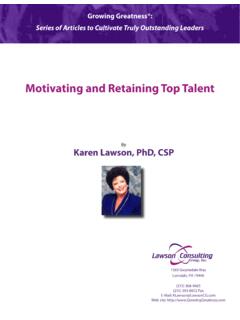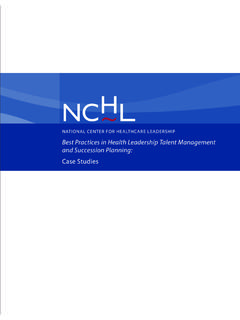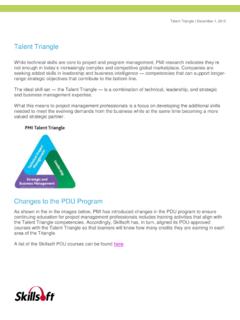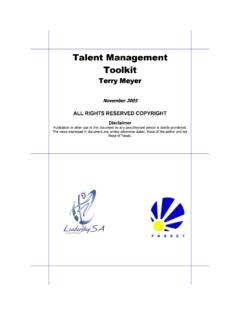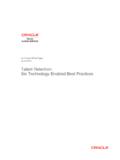Transcription of Nine Best Practices for Effective Talent Management - DDI
1 WHITE PAPER NINE BEST Practices FOR Effective Talent MANAGEMENT1 Development Dimensions International, Inc., MMVI. Revised MMIX. All rights idea of managing Talent is not or five decades ago, it was viewed as aperipheral responsibility best relegated tothe personnel department. Now, Talent man-agement is an organizational function that istaken far more seriously. In The ConferenceBoard s 2007 CEO Challengestudy1, CEOs rankings of the importance of finding qualified managerial Talent increased by 10percentage points or more when comparedto the same research conducted just oneyear earlier. Research conducted in 2008 by DDI and the Economist Intelligence Unit(EIU)2found that 55 percent of executive-level respondents said their firms perform-ance was likely or very likely to suffer in thenear future due to insufficient leadershiptalent.
2 This point of view was reiterated inone-on-one interviews with top executives,conducted as part of the same research emphasis on Talent Management isinevitable given that, on average, companiesnow spend over one-third of their revenueson employee wages and benefits. Yourorganization can create a new product and it is easily copied. Lower your pricesand competitors will follow. Go after alucrative market and someone is there right after you, careful to avoid makingyour initial mistakes. But replicating a high-quality, highly engaged workforce isnearly impossible. The ability to effectivelyhire, retain, deploy, and engage Talent atall levels is really the only true competi-tive advantage an organization PAPERRICHARD S. WELLINS, ,SR. VICE PRESIDENTAUDREY B. SMITH, ,SR. VICE PRESIDENT,EXECUTIVE SOLUTIONSSCOTT ERKER, ,SR.
3 VICE PRESIDENT,SELECTION SOLUTIONSNINE BESTPRACTICES FOR EFFECTIVETALENT MANAGEMENTINTRODUCTIONO rganizations know that they must have the best Talent in order to succeed in the hyper-competitive and increasingly complex global economy. Along with the understanding of the need to hire, develop, and retain talented people, organizations are aware that they must manage Talent as a critical resource to achieve the best possibl e w, if any, organizations today have an ade-quate supply of Talent . Gaps exist at the top of the organization, in the first- to mid-level leadership ranks, and at the front lines. Talent is an increasingly scarce resource, so it must be managed to the fullest the current economic downturn we may experience a short ceasefire in the war for Talent , but we re all seeing new pressure s put on the Talent running our organizations.
4 Are today s leaders able to do more with less? The A-players can, and there should be a strategic emphasis on keeping those lead-ers and developing their successors. Many organizations are reducing their workforces, but let s be careful not to cut so deep that Talent is scarce when the economy PAPER NINE BEST Practices FOR Effective Talent MANAGEMENT2 Talent Management DEFINEDT here is no shortage of definitions for thisterm, used by corporate leadership theworld over. With a nod to other points ofview, DDI defines Talent Management as amission critical process that ensures organi-zations have the quantity and quality ofpeople in place to meet their current andfuture business priorities. The process cov-ers all key aspects of an employee s lifecycle: selection, development, successionand performance components of a highly Effective talentmanagement process include:>A clear understanding of the organization scurrent and future business strategies.
5 >Identification of the key gaps between thetalent in place and the Talent required todrive business success.>A sound Talent Management plan designedto close the Talent gaps. It should also beintegrated with strategic and business plans.>Accurate hiring and promotion decisions.>Connection of individual and team goalsto corporate goals, and providing clearexpectations and feedback to manageperformance.>Development of Talent to enhance per-formance in current positions as well asreadiness for transition to the next level.>A focus not just on the Talent strategyitself, but the elements required for suc-cessful execution.>Business impact and workforce Effective -ness measurement during and S DRIVING THE CURRENT EMPHASIS ON Talent Management ?Organizations have been talking about theconnection between great employees andsuperior organizational performance fordecades.
6 So, why the current emphasis onmanaging Talent ?There are several drivers fueling thisemphasis:1. There is a demonstrated relationshipbetween better Talent and better busi-ness performance. Increasingly, organi-zations seek to quantify the return ontheir investment in Talent . The result is abody of proof that paints a compellingpicture of the impact Talent has on busi-ness performance. To highlight just a few: >A 2007 study from the Hackett Group3found companies that excel at managingtalent post earnings that are 15 percenthigher than peers. For an averageFortune 500 company, such an improve-ment in performance means hundredsof millions of dollars.>A study from IBM found public compa-nies that are more Effective at talentmanagement had higher percentagesof financial outperformers than groupsof similar sized companies with lesseffective Talent >Similarly, a 2006 research study fromMcBassi & that high scor-ers in five categories of human capitalmanagement (leadership Practices ,employee engagement, knowledgeaccountability, workforce organization,and learning capacity) posted higherstock market returns and better safetyrecords two common business goalsthat are top of mind for today s seniorleadership.
7 Development Dimensions International, Inc., MMVI. Revised MMIX. All rights PAPER NINE BEST Practices FOR Effective Talent MANAGEMENT32. Talent is a rapidly increasing sourceof value creation. The financial value ofour companies often depends upon thequality of Talent . In fact, the BrookingsInstitution found that in 1982, 62 percentof an average company s value wasattributed to its physical assets (includingequipment and facilities) and only 38percent to intangible assets (patents, intellectual property, brand, and, most ofall, people). By 2003, these percentagesnearly flip-flopped, with 80 percent ofvalue attributable to intangible assets and20 percent to tangible The context in which we do businessis more complex and makes it more diffi-cult than ever to sustain a competitiveadvantage long term. New products and new business models have shorterlife cycles, demanding constant innova-tion.
8 Technology enables greater accessto information and forces us to move atthe speed of business. Global expansionadds to these challenges a single com-pany may, for example, have its headquar-ters in Japan, its R&D function in China,and its worldwide sales operations basedin as we mentioned already, the recenteconomic downturn following years ofrapid economic growth adds a wholenew dimension to how we manage tal-ent. Record layoffs, lower engagement,and less opportunity for advancementall present additional challenges to man-aging Boards and financial markets areexpecting more. Strategy + Businessmagazine once described CEOs as theworld s most prominent temp workers. 7In 2007, CEO turnover was percent,and the median tenure for a CEO wholeft office was six andinvestors are putting senior leadersunder a microscope, expecting them tocreate value.
9 This pressure, most visibleat the CEO level but generally felt up anddown the org chart, drives a growingemphasis on the quality of Talent notjust at the C-level, but at all Employee expectations are alsochanging. This forces organizationsto place a greater emphasis on talentmanagement strategies and today are:>Increasingly interested in havingchallenging and meaningful work.>More loyal to their profession than tothe organization.>Less accommodating of traditionalstructures and authority.>More concerned about work-lifebalance.>Prepared to take ownership of theircareers and to these myriad challengesmakes it difficult to capture both the hearts and minds of today s work-force. Yet, it s critical to do so, asresearch from IBM and the HumanCapital Institute July2008 study showed that 56 percent offinancial performers understand andaddress employee engagement.
10 This isjust one piece of a large body of evi-dence that illustrates how the culturesbuilt within our organizations are crucialto attracting and retaining key Talent . Development Dimensions International, Inc., MMVI. Revised MMIX. All rights PAPER NINE BEST Practices FOR Effective Talent MANAGEMENT46. Workforce demographics are evolv-ing. Organizations wage a new warfor Talent these days. Today, 60 per-cent of workers over the age of 60 areelecting to postpone their retirementdue to the financial crisis, according toa 2009 survey by top positions, squelching the oppor-tunity for lower-level Talent to advanceand leaving younger workers feelingstuck (and potentially looking for oppor-tunities with other organizations). At alllevels, each deferred exit from the work-force is one less new hire in an alreadydepressed job market.

